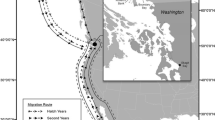Abstract
The frequency and types of malformations are described that were encountered during the spring of 1983 in a natural population of aquatic birds exposed to agricultural drainwater ponds and food items containing high concentrations of selenium in central California. A total of 347 nests of aquatic birds containing 1,681 eggs was selected for study at Kesterson Reservoir located in the Kesterson National Wildlife Refuge (NWR), Merced County, California. Embryos collected during incubation or from eggs that failed to hatch were examined to determine the age at death and presence of malformations. Embryonic death was generally high; approximately 17–60% of the nests of different species contained at least one dead embryo. The incidence of malformed embryos was also high; approximately 22–65% of the nests where at least two embryos were examined contained abnormal embryos. American coots (Fulica americana) and black-necked stilts (Himantopus mexicanus) experienced the highest incidence of malformed embryos. For all species, the average percentage of eggs containing dead or live abnormal embryos was 16.1 whereas the average percentage containing live abnormal embryos was 10.7. Multiple gross malformations of the eyes, brain, and feet were often present. Brain defects included hydrocephaly and exencephaly. Eye defects included both unilateral and bilateral anophthalmia and microphthalmia. Eye and foot defects with ectrodactyly and swollen joints were the most common in coots. Beak defects also occurred frequently and most often included incomplete development of the lower beak of ducks (Anas spp.) and stilts. Wing and leg defects were most prevalent in stilts and ducks, with ectromelia and amelia most prevalent in stilts. Other malformations occurring at lower frequencies included enlarged hearts with thin ventricular walls, liver hypopiasia, and gastroschisis. Based upon simultaneous examination of a control population of aquatic birds of the same species and published studies, the incidences of embryonic mortality and deformities were 9–30 times greater than expected. The role of the form of selenium responsible for teratogenesis in laboratory studies is discussed.
Similar content being viewed by others
References
Arnold RL, Olson OE, Carlson CW (1972) Selenium withdrawal and egg selenium content. Poult Sci 51:341–342
Csallany AS, Su LC, Menken BZ (1984) Effect of selenite, vitamin E, andN,N-diphenyl-p-phenylenediamine on liver organic solvent-soluble lipofuchsin pigments in mice. J Nutr 114:1582–1587
Dougherty JL, Hoekstra WG (1982) Stimulation of lipid peroxidationin vivo by injected selenite and lack of stimulation by selenate. Proc Soc Exp Biol Med 169:209–215
El-Begearmi MM, Sunde ML, Ganther HE (1977) A mutual protective effect of mercury and selenium in Japanese quail. Poult Sci 56:313–322
Franke KW, Tully WC (1935) A new toxicant occurring naturally in certain samples of plant foodstuffs. V. Low hatchability due to deformities in chicks. Poult Sci 14:273–279
Freeman BM, Vince MA (1974) Development of the avian embryo: A behavioral and physiological study. John Wiley & Sons, New York
Gilbertson M, Morris RD, Hunter RA (1976) Abnormal chicks and PCB residue levels in eggs of colonial birds on the lower Great Lakes (1972–73). Auk 93:434–442
Gorenzel WP, Ryder RA, Braun CE (1982) Reproduction and nest site characteristics of American coots at different altitudes in Colorado. Condor 84:59–65
Gruenwald P (1958) Malformations caused by necrosis in the embryo illustrated by the effects of selenium compounds on chick embryos. Am J Pathol 34:77–103
Heinz GH, Hoffman DJ, Krynitsky AJ, Weller DM (1987) Reproduction in mallards fed selenium. Environ Toxicol Chem 6:423–433
Hoffman DJ (1978) Embryotoxic effects of crude oil in mallard ducks and chicks. Toxicol Appl Pharmacol 46:183–190
Hoffman DJ, Heinz GH (1987) Developmental toxicity of excess selenium in mallard (Anas platyrhynchos) ducks. Fed Proc 46:1154
Hunt EG, Naylor AE (1955) Nesting studies of ducks and coots in Honey Lake Valley. Calif Fish Game 41:295–314
Karnofsky DA (1965) The chick embryo in drug screening: Survey of teratological effects observed in the 4-day-old chick embryo. In: Wilson JG, Warkany JK (eds) Teratology: Principles and Techniques. University of Chicago Press, Chicago, pp 194–213
Miller AW, Collins BD (1954) A nesting study of ducks and coots on the Tule Lake and Lower Klamath National Wildlife Refuges. Calif Fish Game 40:17–37
Ohlendorf HM, Hoffman DJ, Saiki MK, Aldrich TW (1986a) Embryonic mortality and abnormalities of aquatic birds: Apparent impacts by selenium from irrigation drainwater. Sci Total Environ 52:49–63
Ohlendorf HM, Hothem RL, Bunck CM, Aldrich TW, Moore JF (1986b) Relationships between selenium concentrations and avian reproduction. Trans N Am Wildl Nat Resour Conf 51:330–342
Ohlendorf HM, Kilness AW, Simmons JL, Stroud RK, Hoffman DJ, Moore JF (1988) Selenium toxicosis in wild aquatic birds. J. Toxicol Environ Health (in press)
Olson OE (1986) Selenium toxicity in animals with emphasis on man. J Am Coll Toxicol 5:45–70
Ort JF, Latshaw JD (1978) The toxic level of sodium selenite in the diet of laying chickens. J Nutr 108:1114–1120
Palmer IS, Arnold RL, Carlson CW (1973) Toxicity of various selenium derivations to chick embryos. Poult Sci 52:1841–1846
Poley WE, Moxon AL (1938) Tolerance levels of seleniferous grains in laying rations. Poult Sci 17:72–76
Poley WE, Moxon AL, Franke KW (1937) Further studies of the effects of selenium poisoning on hatchability. Poult Sci 16:219–225
Pomeroy DE (1962) Birds with abnormal bills. Br Birds 55: 48–72
Presser TS, Ohlendorf HM (1988) Biogeochemical cycling of selenium in the San Joaquin Valley of California, USA. Environ Manage 11:805–821
Subcommittee on Selenium, Committee on Animal Nutrition (1983) Selenium in Nutrition. NRC-NAS, Washington, DC 174 pp
Thapar NT, Guenther E, Carlson CW, Olson OE (1969) Dietary selenium and arsenic additions to diets for chickens over a life cycle. Poult Sci 48:1988–1993
Wilson JG (1965) Embryotogical considerations in teratology. In: Wilson JG, Warkany JK (eds) Teratology: Principles and techniques. University of Chicago Press, Chicago, pp 251–279
Author information
Authors and Affiliations
Rights and permissions
About this article
Cite this article
Hoffman, D.J., Ohlendorf, H.M. & Aldrich, T.W. Selenium teratogenesis in natural populations of aquatic birds in Central California. Arch. Environ. Contam. Toxicol. 17, 519–525 (1988). https://doi.org/10.1007/BF01055518
Received:
Revised:
Issue Date:
DOI: https://doi.org/10.1007/BF01055518




